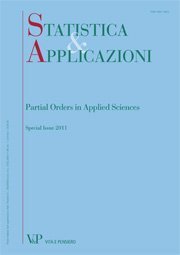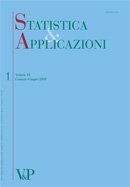Isabella Santini
Author's titles
Perception of poverty. Individual, household and social enviromental determinants
digital


Year:
2011
This paper aims to show to what extent self-perception of poverty is affected by respondent/household
socio-economic characteristics and by social capital endowment of household place of residence
in order to disclose the primary risk factors of family poverty status. Such evidence would
help central and local government to define those economic and social goals which should receive
more attention by current policies with the purpose of advancing towards the eradication of poverty.
In order to purse this aim the logit model has been applied to analyze answers to the dichotomous
transformation of the following question taken from the 2008 Survey on Household Income and
Wealth (SHIW) of the Bank of Italy CONSIDERING YOUR MONTHLY DISPOSABLE INCOME, IS YOUR HOUSEHOLD
ABLE TO MAKE ENDS MEET: (1) WITH GREAT DIFFICULTY, (2) WITH DIFFICULTY, (3) WITH SOME DIFFICULTY,
(4) WITHOUT DIFFICULTY, (5) WITH EASE, (6) WITH GREAT EASE? The results show a relevant effect
on self-perception of poverty of both respondent /household socio-economic characteristics and
social capital. In particular, the components social relationships and social engagement contribute
to reduce the risk of a self-perceived poverty. Actually, networks characterized by relationships of
trust are key determinants of human welfare as people socio-economic vulnerability is reduced as
well as the resources they need only for the fact that they must deal with risk and avert major
losses.
Keywords: Self-perception of Poverty, Social Capital, Household Socio-Economic Characteristics,
Policy-Makers
Italian household debt over the business cycle (1998-2004)
digital


Year:
2009
This paper aims to analyse the socio-economic profile of indebted Italian households and possible changes of such profile occurred in the recession period (2001-2004) with respect to that of expansion (1998 – 2000). In order to pursue this aim, Multiple Correspondence Analysis (MCA) has been applied to the Burt matrix obtained by merging the 1998 and 2000 Surveys on Household Income and Wealth (SHIW) of the Bank of Italy, that is the expansion phase surveys, and setting as supplementary
individuals the rows of the Burt matrix obtained by merging the 2002 and 2004 surveys
(SHIW) of the Bank of Italy, that is the recession phase surveys. Through this double merging, it has been possible to analyse jointly the surveys conducted in two different but homogeneous years as far as macroeconomic trends are concerned. The analysis of the above mentioned data has highlighted that, on the whole, the socio-economic profile of indebted Italian households has undergone, in the recession period with respect to that of expansion, noteworthy changes, partly due to the gradual transformation of instruments used in the payment of instalments on more favourable terms and partly due to the high uncertainty with regard to the general economic perspectives which characterize the recession period.
Keywords: household debt, purchasing behaviour, business cycle, multiple correspondence analysis.
Italian household purchasing behaviour over the business cycle (1997-2004)
digital


Year:
2007
The key implication of the life cycle (LCH – Modigliani and Brumberg, 1954) and of the permanent
income (PIH – Friedman, 1957) theories is that transitory variations in income, such as those arising
from business cycle fluctuations, do not modify the purchasing behaviour of households which
sustain, eventually, consumption either by running down assets and/or by incurring debt. Nevertheless,
several empirical studies have shown that, due to capital market imperfections, during business
cycle recession households, especially those with a severe overall economic situation, are, actually,
forced to reduce the level of consumption of goods with more elastic demand. However, some questions
still need an answer as far as Italian context is concerned: during the business cycle recession,
do households modify their purchasing behaviour varying, apart from the expenditure level, the
share of overall consumption devoted to each category of goods and services? That is, to what extent
are household purchasing decisions concerning the share of overall consumption devoted to
each category of goods and services consistent with the economic theories on the inter-temporal allocation
of resources developed by Modigliani and Brumberg (1954) and by Friedman (1957)? With
this objective in mind, it will be highlighted if and how much the composition of Italian household
expenditures according to the COICOP divisions changed in the recession phase (2001-2004) with
respect to that of expansion (1997-2000), applying, to the data from Italian Household Expenditure
Surveys, the Correspondence Analysis for three-way tables (Escofier and Drouet, 1983).
Capitale sociale e processi produttivi locali: un’analisi a livello provinciale
digital


Year:
2005
How strong is the impact of social capital on the production process? What kind of relationship links social capital to traditional input factors, such as labour and physical capital? This paper attempts to answer to these questions at a macroeconomic level.
Browse the archive
Online First Articles
Recent issues
STATISTICA & APPLICAZIONI - 2022 - 2
STATISTICA & APPLICAZIONI - 2022 - 1
STATISTICA & APPLICAZIONI - 2021 - 2
STATISTICA & APPLICAZIONI - 2022 - 1
STATISTICA & APPLICAZIONI - 2021 - 2









